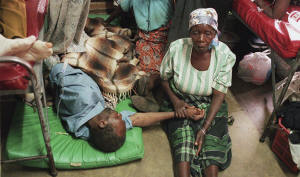This is what happens to the body when HIV drugs are stopped for millions
of people
 Send a link to a friend
Send a link to a friend
 [February 13, 2025]
By The Associated Press [February 13, 2025]
By The Associated Press
A generation has passed since the world saw the peak in AIDS-related
deaths. Those deaths — agonizing, from diseases the body might otherwise
fight off — sent loved ones into the streets, pressuring governments to
act. The United States eventually did, creating PEPFAR, arguably the
most successful foreign aid program in history. HIV, which causes AIDS,
is now manageable, though there is still no cure.
Now the Trump administration has put the brakes on foreign aid while
alleging it's wasteful, causing chaos in the system that for over 20
years has kept millions of people alive. Confusion over a temporary
waiver for PEPFAR — and the difficulty of restarting its work, with U.S.
workers, contractors and payments in upheaval — means the clock is
ticking for many who are suddenly unable to obtain medications to keep
AIDS at bay.
The U.S.-led global response to HIV has been so effective that AIDS
wards of people wasting away are a vision of the past. Now health
experts, patients and others fear those days could return if the Trump
administration doesn’t reverse course or no other global power steps
into the void, and fast.
“In the next five years, we could have 6.3 million AIDS-related deaths,”
the U.N. AIDS agency told The Associated Press. That's a shock at a time
of rising complacency around HIV, declining condom use among some young
people and the rise of a medication that some believe could end AIDS for
good.
The agency has begun publicly tracking new HIV infections since the aid
freeze.
Here’s a look at what happens to the body when HIV drugs are stopped:

An immune system collapse
HIV is spread by bodily fluids such as blood, breast milk or semen. It
gradually weakens the body’s immune system and makes it vulnerable to
disease, including ones rarely seen in otherwise healthy people. The
surprising emergence of such cases in the 1980s is what tipped off
health experts to what became known as the AIDS epidemic.
Years of intense advocacy and shocking sights of children, young adults
and others dying of pneumonia and other infections led to the response
that created PEPFAR, the President’s Emergency Plan for AIDS Relief.
Twenty million people around the world died before the program was
founded. Now millions of people take drugs known as antivirals that keep
HIV from spreading in the body.
Stopping those drugs lets the virus start multiplying in the body again,
and it could become drug-resistant. HIV can rebound to detectable levels
in people’s blood in just a few weeks, putting sexual partners at risk.
Babies born to mothers with HIV can escape infection only if the woman
was properly treated during pregnancy or the infant is treated
immediately after birth.
If the drugs are not taken, a body is heading toward AIDS, the final
stage of infection.
[to top of second column]
|

A woman holds the hand of a sick relative lying on the floor of the
overcrowded Lilongwe Central Hospital, in Lilongwe, Malawi, Sept.
30, 1998, as the hospital is overflowing because of an epidemic of
AIDS rampaging in southern Africa. (AP Photo /Denis Farrell, File)
 The daily danger of germs
“Without HIV treatment, people with AIDS typically survive about
three years,” the Centers for Disease Control and Prevention says.
For a long time, there may be no noticeable symptoms. But a person
can easily spread HIV to others, and the immune system becomes
vulnerable to what are called opportunistic diseases.
The National Institutes of Health says opportunistic diseases
include fungal infections, pneumonia, salmonella and tuberculosis.
For a country like South Africa, with the world’s highest number of
HIV cases and one of the largest numbers of TB cases, the toll could
be immense.
Unchecked by HIV treatment, the damage continues. The immune system
is increasingly unable to fight off diseases. Every action, from
eating to travel, must consider the potential exposure to germs.
Every day counts
For years, the importance of taking the drugs every day, even at the
same time of day, has been emphasized to people with HIV. Now the
ability to follow that essential rule has been shaken.
Already, hundreds or thousands of U.S.-funded health partners in
countries such as Kenya and Ethiopia have been laid off, causing
widespread gaps in HIV testing, messaging, care and support on the
continent most helped by PEPFAR. At some African clinics, people
with HIV have been turned away.
Restoring the effects caused by the Trump administration's foreign
aid freeze during a 90-day review period, and understanding what’s
allowed under the waiver for PEPFAR, will take time that health
experts say many people don't have.
Meanwhile, the head of the U.N. AIDS agency, Winnie Byanyima, told
the AP that more resistant strains of the disease could emerge.
And an additional 3.4 million children could be made orphans —
another echo of the time when the world raced to confront AIDS with
few tools at hand.
All contents © copyright 2025 Associated Press. All rights reserved
 |